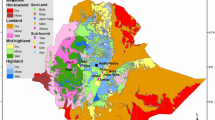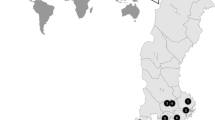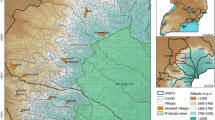Abstract
Natural resource degradation in highland regions is of increasing concern to the global community due to its role in aggravating poverty and the loss of environmental services to local and downstream users. The integration of trees into smallholder farming systems has been promoted as a means to enhance rural livelihoods while reversing the degradation of soil, water, biodiversity and related environmental services. Yet in addition to these benefits, negative impacts of trees on certain stakeholders or system components have also accompanied such efforts—suggesting that important trade-offs accompany afforestation. This paper presents a methodology for diagnosing problems stemming from cultivation of certain tree species in specific landscape niches. Data derived from the application of this methodology in two sites in the eastern African highlands are presented. Participatory diagnoses of landscape-level problems suggest that the negative impact of trees on water resource availability and crop yield are of critical concern to smallholder farmers. Ethnoecological data highlight the properties of different tree species that determine their suitability to specific farm and landscape niches. These data point to important opportunities for more socially- and environmentally-optimal integration of indigenous and exotic tree species into agricultural landscapes, and highlight the critical importance of local knowledge in forging solutions appropriate to contemporary realities.
Similar content being viewed by others
References
Akbar, G., Ahmad, M., Rafique, S., & Babar, K. N. (1990). Effect of trees on the yield of wheat crop. Agroforestry Systems, 11, 1–10.
Ardayfio, E. (1986). The Rural Energy Crisis in Ghana: Its Implications for Women’s Work and Household Survival, World Employment Programme Research Working Paper No. 39, ILO, Geneva.
Arnold, J. E. M. (1992). Community forestry: Ten years in review. Rome: FAO.
Bachrach, P., & Baratz, M. S. (1970). Power and poverty: Theory and practice. New York: Oxford University Press, pp. 220.
Becker, B. (1986). Wild plants for human nutrition in the Sahelian zone. Journal of Arid Environments, 11, 61–64.
Bekele, M. (2003). ‘Forest property rights, the role of the state and institutional exigency: The Ethiopian experience’, Ph.D. Thesis, Swedish University of Agricultural Sciences, Uppsala, 220 pp.
Bernard, R. H. (1994). Research methods in anthropology: Qualitative and quantitative approaches (2nd ed.). Walnut Creek, CA: Altamira Press, pp. 588.
Bonnard, P., & Scherr, S. (1994). Within gender differences in tree management: Is gender distinction a reliable concept?. Agroforestry Systems, 25, 71–93.
Caveness, F. A., & Kurtz, W. B. (1993). Agroforestry adoption and risk perception by farmers in Senegal. Agroforestry Systems, 21, 11–25.
CGIAR (2002). Putting integrated natural resource management into action. Proceedings of the 4th INRM Workshop, Aleppo, Syria, September 2002, 98 pp. Aleppo: ICARDA.
Conte, C. A. (1999). The forest becomes a desert: Forest use and environmental change in Tanzania’s West Usambara mountains. Land Degradation & Development, 10, 291–309.
D’Andrade, R. G. (1995). The development of cognitive anthropology. Cambridge: Cambridge University Press, pp 286.
Denning, G. (2001). Realising the potential of agroforestry: Integrating research and development to achieve greater impact. Development in Practice, 11(4), 407–416.
FAO (1976). Forests for research and development. FAO, Rome.
FAO (1986). Restoring the balance: Women and forest resources. Rome: FAO.
Fernandes, E. C. M. (1990). Alley cropping on an acid soil in the Peruvian Amazon: Mulch, fertilizer and Hedgerow root pruning effects. Ph.D. Thesis, North Carolina State University, Raleigh, NC.
Franzel, S., Cooper, P., & Denning, G. (2001). Scaling up the benefits of agroforestry research. Development in Practice, 11(4), 524–534.
German, L., Tolera, T., & Charamila, S. (in press). Managing trade-offs in agroforestry: From conflict to collaboration in natural resource management. In: A. S. Klappa, & D. Russell (Eds.), Cultured trees: Transformations in agroforestry systems. New York: Berghahn Books.
Gutteridge, R. C., & Shelton, H. M. (1993). The scope and potential of tree legumes in agroforestry. Agroforestry Systems, 23(2–3), 177–194.
Ivory, D. A. (1990). Major characteristics, agronomic features and nutritional value of shrubs and tree fodders. In: C. Devendra (Ed.), Shrub and tree fodders for farm animals: Workshop proceedings. Denpasar, Indonesia, July 1989. Ottowa, Canda: IDRC.
Kang, B. T., Reynolds, L., & Atta-Krah, A. N. (1990). Alley farming. Advances in Agronomy, 43, 315–359.
Knox, A., Meinzen-Dick, R., & Hazell, P. (2002). Property rights, collective action, and technologies for natural resource management: A conceptual framework. In: R. Meinzen-Dick, A. Knox, F. Place, B. Swallow (Eds.), Innovation in natural resource management: The role of property rights and collective action in developing countries (pp. 12–44). Baltimore: Johns Hopkins University Press.
Kruskal, J. B., & Wish, M. (1978). Multidimensional scaling: Quantitative applications in the social sciences. Newbury Park, CA: Sage Publications, pp. 96.
Larsson, U. (1990). Trees as cash crops: Commercial value of trees and forests in Babati district. Uppsala: Swedish University of Agricultural Sciences.
Le Maitre, D. C., Versfeld, D. B., & Chapman, R. A. (2000). The impact of invading alien plants on surface water resources in South Africa: A preliminary assessment. Water SA, 26(3), 397–402.
Lundgren, B. O. (1982). Cited in Editorial: ‘What is Agroforestry?’. Agroforestry Systems, 1, 7–12.
Lwakuba, A., Kaudia, A. A., & Okorio, J. (2003). Agroforestry handbook for the montane zone of Uganda. Technical Handbook No. 31, RELMA, Nairobi.
Meinzen-Dick, R., Knox, A., Place, F., & Swallow, B. (2002). Innovation in natural resource management: The role of property rights and collective action in developing countries. Washington, D.C.: IFPRI, pp. 317.
Munk Ravnborg, H., & Ashby, J. A. (1996). Organising for local-level watershed management: Lessons from Rio Cabuyal watershed, Colombia. AgREN Network Paper, 65, 14.
Nair, P. K. R. (1984). Soil productivity aspects of agroforestry. Nairobi, Kenya: ICRAF, pp. 85.
Nair, P. K. R. (1993). An introduction to agroforestry. Dordrecht: Kluwer Academic Publishers, pp. 499.
Omiti, J. M., Parton, K. A., Sinden, J. A., & Ehui, S. K. (1999). Monitoring changes in land-use practices following Agrarian De-Collectivisation in Ethiopia. Agriculture, Ecosystems and Environment, 72, 111–118.
Ostrom, E. (1990). Governing the commons: The evolution of institutions for collective action. Cambridge, UK: Cambridge University Press, pp. 298.
Ostrom, E. (1998). The institutional analysis and development approach. In: E. T. Loehman, D. M. Kilgour (Eds.), Designing institutions for environmental and resource management (pp. 68–90). Chelthenam, UK: Edward Elgar Publishing.
Pandey, S., & Yadama, G. N. (1990). Conditions for local level community forestry action: A theoretical explanation. Mountain Research and Development, 10(1), 88–95.
Pellow, D. N. (1998). Negotiation and confrontation: Environmental policymaking through consensus. Society & Natural Resources, 12, 189–203.
Rocheleau, D., Edmunds, D. (1997). Women, men and trees: Gender, power and property in forest and Agrarian landscapes. World Development, 25(8), 1351–1371.
Russell, D., & Harshbarger, C. (2003). Groundwork for community-based conservation: Strategies for social research. Walnut Creek, CA: Altamira Press, pp. 322.
Schroeder, R. A. (1993). Shady Practice: Gender and the Political Ecology of Resource Stabilization in Gambian Garden/Orchards. Economic Geography, 69(4), 349–365.
Scoones, I., & Thompson, J. (2003). Participatory processes for policy change. PLA Notes, 46, 100.
Shelton, H. M. (1998). Environmental adaptation of forage tree legumes. In: R. C. Gutteridge, H. M. Shelton (Eds.), Forage tree legumes in tropical agriculture (pp. 120–131). Wallingford, UK: CAB International.
Ssekabembe, C. K. (Eds.), (2004). Agroforestry approach to land use: A training manual for extension agents. Kampala: Makerere University Press, pp. 229.
Wittayapak, C., & Dearden, P. (1999). Decision-making arrangements in community-based watershed management in Northern Thailand. Society & Natural Resources, 12, 673–691.
Young, A. (1989). Agroforestry for soil conservation. Wallingford, Oxford, UK: CAB International, pp. 284.
Acknowledgements
The authors would like to acknowledge the conceptual contributions of AHI site teams of Ethiopia (Holetta Agricultural Research Centre) and Tanzania (Mlingano Agricultural Research Institute, Selian Agricultural Research Institute); the African Highlands Initiative (in particular Dr. Ann Stroud); and our donors (Rockefeller Foundation, SDC, the Netherlands and Norwegian governments, IDRC and DFID) for their generous financial support.
Author information
Authors and Affiliations
Corresponding author
Rights and permissions
About this article
Cite this article
German, L., Kidane, B. & Shemdoe, R. Social and environmental trade-offs in tree species selection: a methodology for identifying niche incompatibilities in agroforestry. Environ Dev Sustain 8, 535–552 (2006). https://doi.org/10.1007/s10668-006-9054-3
Received:
Accepted:
Published:
Issue Date:
DOI: https://doi.org/10.1007/s10668-006-9054-3




